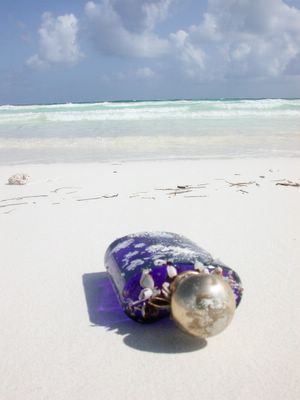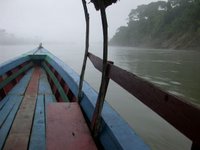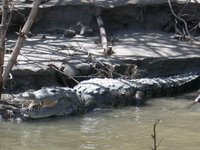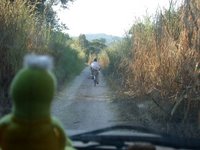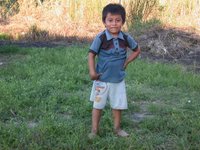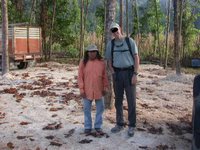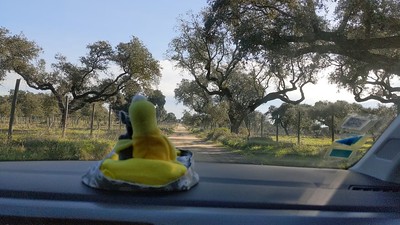
Showing posts with label road notes. Show all posts
Showing posts with label road notes. Show all posts
10/07/2021
16/04/2021
27/06/2006
Photos from Campeche
It's been six days since my knee surgery and my leg is still pre-tee sore. I worked in my office for several hours today but then was suddenly overcome by a deep fatigue and napped for about an hour. Since then I've been having a fine old time doing things I'm generally too busy for such as ... paying attention to details. Perhaps this reconstruction and recuperation thing is generalizing.
Among details I've slowed down to notice are the 10,000 photos I took in the Yucatan last fall. This afternoon I sorted through a few and will post today'’s batch between Flickr, my website (the Mexico Diary is meager) and here. I focused on Campeche, one of my all-time favorite cities and places to live. In my mind. Campeche has a lot of problems. But it also has some of my favorite qualities. Campeche is sea-swept, ancient, hip, beautiful and ambiguous. Even its mold participates in the town's implied art life.
Mr. Lee and I are going to watch a movie now so here's one photo for tonight and a promise of more tomorrow.
Labels:
Mexico,
photos,
road notes,
travel notes
12/02/2006
The old bottle and the sea
For some reason this bottle has been on my mind for the last couple of days. I photographed it while we were camping on the Caribbean last November.
It was a lovely glass home for the several creatures clinging to its neck. The clouds drifting over the sea are from the edge of a hurricane that was passing by not too far south.
Labels:
Mexico,
photos,
road notes,
travel notes
01/01/2006
Slow motion adventure
 I love Ashland Oregon. I lived there a long time and still need to visit occasionally to spend time with old friends like Bob the Cat and get my Ashland fix. Where else can you count on seeing more than one PETA bumpersticker in a day or ever? Kindness and compassion are everday occurances in Ashland, not exceptions. But the good news is ...we're back in Nevada!
I love Ashland Oregon. I lived there a long time and still need to visit occasionally to spend time with old friends like Bob the Cat and get my Ashland fix. Where else can you count on seeing more than one PETA bumpersticker in a day or ever? Kindness and compassion are everday occurances in Ashland, not exceptions. But the good news is ...we're back in Nevada! 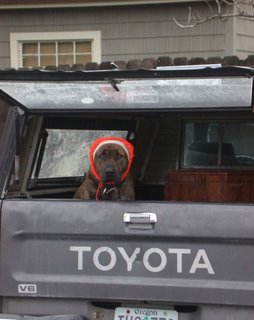 It's a long time gone counting the two months we just spent in the Yucatan. Add the ten days we spent in rainy Oregon during Christmas and by Friday all we wanted was to be home by the end of the year. We are both so sick of the gray, the cold and the wet. Hurricanes and tropical storms chased us prematurely out of the Caribbean and an almost constant rain chased us out of the Rogue Valley. Usually it takes us less than six hours to get back. This time it took nearly eleven. To begin with, I-5 was closed just south of Ashland. Mud slide but not a trip ender. We decided to take Hwy. 66 instead. It goes east over the mountains to Klamath Falls and Lakeview, then south to Nevada. A bit longer but no big deal. At the end of the valley, just before the road begins its ascent, there is a small creek that feeds Immigrant Lake. It had risen into the trees but we crossed with no problem and began climbing up out of the valley. Cars were coming down the hill so we felt like geniuses. Briefly.
It's a long time gone counting the two months we just spent in the Yucatan. Add the ten days we spent in rainy Oregon during Christmas and by Friday all we wanted was to be home by the end of the year. We are both so sick of the gray, the cold and the wet. Hurricanes and tropical storms chased us prematurely out of the Caribbean and an almost constant rain chased us out of the Rogue Valley. Usually it takes us less than six hours to get back. This time it took nearly eleven. To begin with, I-5 was closed just south of Ashland. Mud slide but not a trip ender. We decided to take Hwy. 66 instead. It goes east over the mountains to Klamath Falls and Lakeview, then south to Nevada. A bit longer but no big deal. At the end of the valley, just before the road begins its ascent, there is a small creek that feeds Immigrant Lake. It had risen into the trees but we crossed with no problem and began climbing up out of the valley. Cars were coming down the hill so we felt like geniuses. Briefly. What we didn't count on was the strain very wet snow puts on trees. When we got to the Green Springs Inn at the summit we learned that the road ahead was closed. Trees, over-burdened by heavy snow, had fallen over the road, plus two vehicles had spun out of control and were also blocking the highway. With no snow plow or road crew in sight we turned around and headed back down. Our plan now was to get back across the creek and over to Hwy 140 as it goes in the same general direction.
What we didn't count on was the strain very wet snow puts on trees. When we got to the Green Springs Inn at the summit we learned that the road ahead was closed. Trees, over-burdened by heavy snow, had fallen over the road, plus two vehicles had spun out of control and were also blocking the highway. With no snow plow or road crew in sight we turned around and headed back down. Our plan now was to get back across the creek and over to Hwy 140 as it goes in the same general direction.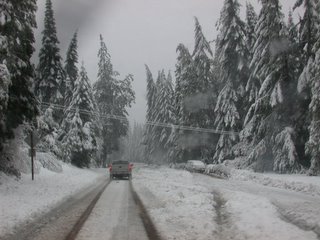 Hwy 66 is a narrow band etched into very steep terrain. For the most part, there are no guard rails, no pull outs and turn-arounds are miles apart and the drop from the side of the road is chillingly steep. On our way down, cars were coming up. A good sign. The creek was still crossable. However, when we got to the bottom we were greeted by another surprise. Immigrant Creek had flooded the road carrying a snarl of logs and brush along in its muddy torrent. Someone told us that the road up top was now clear so … up we went … again. Our other option was to sit in the jeep and watch water gush down the hill on our right and rise up onto the road on our left.
Hwy 66 is a narrow band etched into very steep terrain. For the most part, there are no guard rails, no pull outs and turn-arounds are miles apart and the drop from the side of the road is chillingly steep. On our way down, cars were coming up. A good sign. The creek was still crossable. However, when we got to the bottom we were greeted by another surprise. Immigrant Creek had flooded the road carrying a snarl of logs and brush along in its muddy torrent. Someone told us that the road up top was now clear so … up we went … again. Our other option was to sit in the jeep and watch water gush down the hill on our right and rise up onto the road on our left.A lot of cars were parked at the Inn but we were in no mood to wait. The jeep is the right vehicle for a situation like that but we'd burned a lot of time going nowhere and at some point we were going to run out of daylight. The trees had been cut away only enough to make a narrow passage and the open road wasn't much better.
 Of the few vehicles out, most were cars and they were fishtailing in slow motion or stuck on small inclines without chains. It was a mess. It's one thing speeding along at 70 mph with a belly full of Christmas cheer, the music and heat cranked up. It's another when you are suddenly forced out of that bubble. One guy was in the snow, no coat, no gloves, drenched, freezing, putting on chains after he got stuck. Bad idea. On this road, tow trucks and snow plows are not standing by and it's not Christmas. It's winter.
Of the few vehicles out, most were cars and they were fishtailing in slow motion or stuck on small inclines without chains. It was a mess. It's one thing speeding along at 70 mph with a belly full of Christmas cheer, the music and heat cranked up. It's another when you are suddenly forced out of that bubble. One guy was in the snow, no coat, no gloves, drenched, freezing, putting on chains after he got stuck. Bad idea. On this road, tow trucks and snow plows are not standing by and it's not Christmas. It's winter.But no matter how well prepared you are there is always the unforeseeable. We got to Lakeview at twilight, by that point debating whether or not to stop for the night. Mr. Lee's argument was that we were now below the snow line and on a straight, desert highway. What could possibly go wrong? Sounded good. Once we had driven an hour into dark nowhere we found out. The headlights stopped working. He managed to coax them on, over and over, and I sat with the giant flashlight to ward off cars, just in case. Finally a big rig turned onto the road and we stayed behind that, using it as a shield until we got near Susanville.
Susanville is an armpit on a good day but I wanted to stop there for the night anyway and drive home in daylight but the possibility of being trapped over New Year's waiting for a garage and parts made Mr. Lee crazy. He wanted a coin toss but, by that time, the lights had worked for over an hour so I agreed to keep going. I wasn't in the mood to let a fucking coin decide anything. We got home by midnight. Delicata was snuggled into her hot hut. The lights, heat, water and internet worked. I call that good.
 It's not New Orleans and it's not as bad as '97, but Carson City has declared a disaster and there is flooding from Reno to Gardnerville. In hindsight, I see that the whole way home the door was closing behind us but now, finally, the rain has let up so this morning, this first day of 2006, here's a toast to narrow misses, happy endings and a great new year. Remember to eat your black-eyed peas for good luck!
It's not New Orleans and it's not as bad as '97, but Carson City has declared a disaster and there is flooding from Reno to Gardnerville. In hindsight, I see that the whole way home the door was closing behind us but now, finally, the rain has let up so this morning, this first day of 2006, here's a toast to narrow misses, happy endings and a great new year. Remember to eat your black-eyed peas for good luck!
Labels:
photos,
road notes,
travel notes
05/12/2005
Street scenes, Mexico
Here are a couple of photos I took in Mexico recently. To me, these two particular images have a lot in common.
Labels:
Mexico,
photos,
road notes,
travel notes
01/12/2005
Home again
 We're back from the Yucatan. Over the all, we drove about 10,000 miles so my photo to miles ratio held at 1+:1, the 1+ plus being the number of photos and the 1 being the mileage. Not bad. I've deleted a lot and will delete many more. Then there are the ones that make sense only to me. I'll keep those. Among the remainder, there are a few worthy of presenting to you, the rare, much appreciated, occasional visitor to this tiny outpost border crossing. Also, naturally, I have a few things to say about the trip and, for your traveling convenience, I have compiled a list of tips for people brave enough to leave the gringo trail and travel in real Mexico. All this to come. At the moment, I must get coffee. Outside of tourist joints it is nearly impossible to get a good cup of coffee in Mexico, the land of coffee, a fact I find nearly impossible to comprehend.
We're back from the Yucatan. Over the all, we drove about 10,000 miles so my photo to miles ratio held at 1+:1, the 1+ plus being the number of photos and the 1 being the mileage. Not bad. I've deleted a lot and will delete many more. Then there are the ones that make sense only to me. I'll keep those. Among the remainder, there are a few worthy of presenting to you, the rare, much appreciated, occasional visitor to this tiny outpost border crossing. Also, naturally, I have a few things to say about the trip and, for your traveling convenience, I have compiled a list of tips for people brave enough to leave the gringo trail and travel in real Mexico. All this to come. At the moment, I must get coffee. Outside of tourist joints it is nearly impossible to get a good cup of coffee in Mexico, the land of coffee, a fact I find nearly impossible to comprehend.
Labels:
Mexico,
photos,
road notes,
travel notes
25/11/2005
Right to NOT die
2105
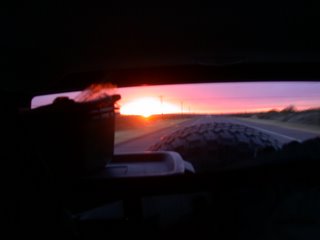 We crossed into New Mexico this morning and are currently, happily, tucked in into the Sands Motel in Socorro, New Mexico. It's a great, family-owned place directly out of the '50s except for the fact that the owners are a nice, vegetarian family from India and we have high speed internet in the room. A fantastic deal all for $40. This morning we stopped to visit the International UFO Museum & Research Center in Roswell. Nothing new there but it was fun anyway.
We crossed into New Mexico this morning and are currently, happily, tucked in into the Sands Motel in Socorro, New Mexico. It's a great, family-owned place directly out of the '50s except for the fact that the owners are a nice, vegetarian family from India and we have high speed internet in the room. A fantastic deal all for $40. This morning we stopped to visit the International UFO Museum & Research Center in Roswell. Nothing new there but it was fun anyway.
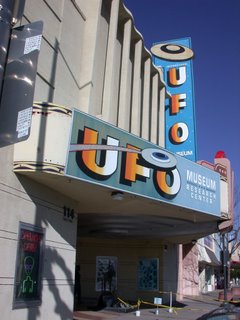 I admit, I have been a "believer" since childhood. At that time, I was in the habit of secretly staying up past bedtime to scan the skies for flying saucers with my binoculars. One night a milky white, quarter size light suddenly shot into the open skies above the trees. I dumped the binocs and
I admit, I have been a "believer" since childhood. At that time, I was in the habit of secretly staying up past bedtime to scan the skies for flying saucers with my binoculars. One night a milky white, quarter size light suddenly shot into the open skies above the trees. I dumped the binocs and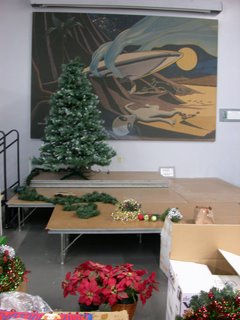 watched. It was climbing very quickly so in seconds it passed over the house and out of sight. I ran to my parent's bedroom and looked out their window. Nothing. I ran back to my room and looked out my window again.
To my total wonder and delight, there were now four milky white, quarter size lights stopped in the sky above my
watched. It was climbing very quickly so in seconds it passed over the house and out of sight. I ran to my parent's bedroom and looked out their window. Nothing. I ran back to my room and looked out my window again.
To my total wonder and delight, there were now four milky white, quarter size lights stopped in the sky above my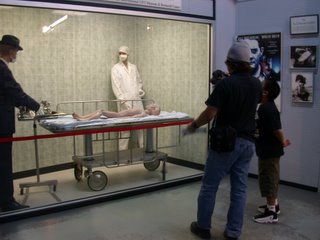 room. They had formed a square, and hung perfectly still in the night sky. They stayed like that for about a half a minute then the three in the SW, NW, and NE corners, maintaining formation, broke off and quickly disappeared above the trees to the NE. The fourth one, in the SE corner of the square, shot away in that direction, retracing the path of the original light. That was it. No funny scars.
No weird dreams-like memories but I have been looking ever since so, no matter how hokey, stopping at the museum was a must.
room. They had formed a square, and hung perfectly still in the night sky. They stayed like that for about a half a minute then the three in the SW, NW, and NE corners, maintaining formation, broke off and quickly disappeared above the trees to the NE. The fourth one, in the SE corner of the square, shot away in that direction, retracing the path of the original light. That was it. No funny scars.
No weird dreams-like memories but I have been looking ever since so, no matter how hokey, stopping at the museum was a must.
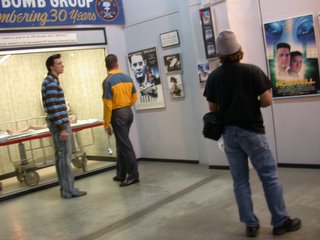 A bit further down the road we pulled over to visit Smokey Bear's grave and museum. It cost two bucks to walk the path to Smokey's grave so we peaked over the wall instead but the museum was a free, sweet, homespun place housed in a small log cabin.
A bit further down the road we pulled over to visit Smokey Bear's grave and museum. It cost two bucks to walk the path to Smokey's grave so we peaked over the wall instead but the museum was a free, sweet, homespun place housed in a small log cabin. 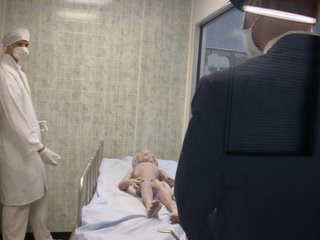 There were the usual things ... tshirts, cups, hats, jewelery etc. but there was also a wonderful collection of Smokey Bear memorabilia including photos of baby Smokey, anitque posters and products long out of circulation and several scrap books of Smokey's newspaper clippings, photos and lots of hand scrawled fan letters to Smokey from grade school kids from the 40's on.
There were the usual things ... tshirts, cups, hats, jewelery etc. but there was also a wonderful collection of Smokey Bear memorabilia including photos of baby Smokey, anitque posters and products long out of circulation and several scrap books of Smokey's newspaper clippings, photos and lots of hand scrawled fan letters to Smokey from grade school kids from the 40's on.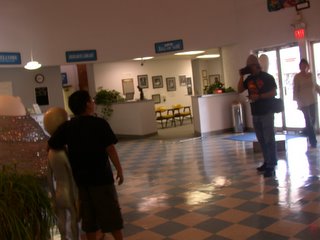 A little while later we passed the last stronghold of Billy the Kid. New Mexico! Great place.
A little while later we passed the last stronghold of Billy the Kid. New Mexico! Great place.
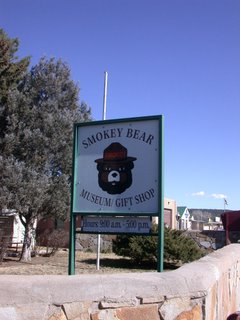
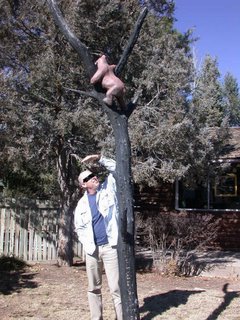
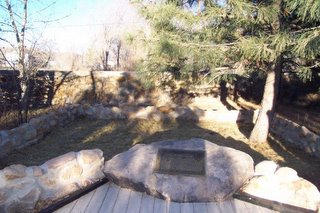 Smokey the Bear's Grave, New Mexico
Smokey the Bear's Grave, New Mexico
Commenting on the Iraq war, Washington Post Op-Ed Columnist Michael Kinsley said today: "The last man or woman to die in any war almost surely dies in vain: The outcome has been determined, if not certified. And he or she might die happier thinking that death came in a noble cause that will not be abandoned. But if it is not a noble cause, he or she might prefer not to die at all. Stifling criticism that might shorten the war is no favor to American soldiers. They can live without that kind of "respect." - kinsleym@washpost.com --------------------- I couldn't agree more.
 We crossed into New Mexico this morning and are currently, happily, tucked in into the Sands Motel in Socorro, New Mexico. It's a great, family-owned place directly out of the '50s except for the fact that the owners are a nice, vegetarian family from India and we have high speed internet in the room. A fantastic deal all for $40. This morning we stopped to visit the International UFO Museum & Research Center in Roswell. Nothing new there but it was fun anyway.
We crossed into New Mexico this morning and are currently, happily, tucked in into the Sands Motel in Socorro, New Mexico. It's a great, family-owned place directly out of the '50s except for the fact that the owners are a nice, vegetarian family from India and we have high speed internet in the room. A fantastic deal all for $40. This morning we stopped to visit the International UFO Museum & Research Center in Roswell. Nothing new there but it was fun anyway.
 I admit, I have been a "believer" since childhood. At that time, I was in the habit of secretly staying up past bedtime to scan the skies for flying saucers with my binoculars. One night a milky white, quarter size light suddenly shot into the open skies above the trees. I dumped the binocs and
I admit, I have been a "believer" since childhood. At that time, I was in the habit of secretly staying up past bedtime to scan the skies for flying saucers with my binoculars. One night a milky white, quarter size light suddenly shot into the open skies above the trees. I dumped the binocs and watched. It was climbing very quickly so in seconds it passed over the house and out of sight. I ran to my parent's bedroom and looked out their window. Nothing. I ran back to my room and looked out my window again.
To my total wonder and delight, there were now four milky white, quarter size lights stopped in the sky above my
watched. It was climbing very quickly so in seconds it passed over the house and out of sight. I ran to my parent's bedroom and looked out their window. Nothing. I ran back to my room and looked out my window again.
To my total wonder and delight, there were now four milky white, quarter size lights stopped in the sky above my room. They had formed a square, and hung perfectly still in the night sky. They stayed like that for about a half a minute then the three in the SW, NW, and NE corners, maintaining formation, broke off and quickly disappeared above the trees to the NE. The fourth one, in the SE corner of the square, shot away in that direction, retracing the path of the original light. That was it. No funny scars.
No weird dreams-like memories but I have been looking ever since so, no matter how hokey, stopping at the museum was a must.
room. They had formed a square, and hung perfectly still in the night sky. They stayed like that for about a half a minute then the three in the SW, NW, and NE corners, maintaining formation, broke off and quickly disappeared above the trees to the NE. The fourth one, in the SE corner of the square, shot away in that direction, retracing the path of the original light. That was it. No funny scars.
No weird dreams-like memories but I have been looking ever since so, no matter how hokey, stopping at the museum was a must.
 A bit further down the road we pulled over to visit Smokey Bear's grave and museum. It cost two bucks to walk the path to Smokey's grave so we peaked over the wall instead but the museum was a free, sweet, homespun place housed in a small log cabin.
A bit further down the road we pulled over to visit Smokey Bear's grave and museum. It cost two bucks to walk the path to Smokey's grave so we peaked over the wall instead but the museum was a free, sweet, homespun place housed in a small log cabin.  There were the usual things ... tshirts, cups, hats, jewelery etc. but there was also a wonderful collection of Smokey Bear memorabilia including photos of baby Smokey, anitque posters and products long out of circulation and several scrap books of Smokey's newspaper clippings, photos and lots of hand scrawled fan letters to Smokey from grade school kids from the 40's on.
There were the usual things ... tshirts, cups, hats, jewelery etc. but there was also a wonderful collection of Smokey Bear memorabilia including photos of baby Smokey, anitque posters and products long out of circulation and several scrap books of Smokey's newspaper clippings, photos and lots of hand scrawled fan letters to Smokey from grade school kids from the 40's on. A little while later we passed the last stronghold of Billy the Kid. New Mexico! Great place.
A little while later we passed the last stronghold of Billy the Kid. New Mexico! Great place.


 Smokey the Bear's Grave, New Mexico
Smokey the Bear's Grave, New Mexico
Labels:
photos,
road notes,
travel notes
22/11/2005
Cuidad Victoria, looking back
So far we have made it to Cuidad Victoria. Tomorrow Texas. In the end, I guess you could say we were driven out of Mexico by the hurricanes and tropical storms. Gamma was just one too many. Too bad. The place we were camping was terrific, plus Lee needed a break. Driving in Mexico is really, really difficult! I wouldn't want to do it. I'll go into more detail when I have more time. Last year we didn't drive nearly as much. We rented an apartment in Oaxaca for six weeks. It was cheap and restful. At least as restful as living downtown in a noisy, polluted city allows. I didn't sleep much and got kind of crazy but I like the poems I wrote in Oaxaco so can't complain too much. This trip was very different. We visited tons of Mayan ruins. Megatons. Muchomegatons. It was a "trip of a lifetime" kind of thing. But we drove daily. Mr. Lee drove daily and Mexican roads are terrible, the maps don't work, the guide books are wrong and the signs, when they exist, are impossible.
My time at the cafe is almost up but just quickly, Mexico changed the way I see the world and the way I view my own life. For starters, human history is no longer the exclusive story of the East. It has completely independent roots south of the Rio Grand, or Rio Bravo as that river is called in Mexico. Perhaps the Aliens augmented monkey intelligence in both hemispheres at the same time, but the Olmecs, Mayans and Aztecs evolved independently from the rest of the world from that point on. And, as with my first visit to Mexico, I have again struggled daily with the contradictions, poverty, community, beauty and suffering that inundates me moment to moment in this foreign sister America. And, like last year, I am returning home with a renewed appreciation of the US, the American people (not our radical right wing government) and what we have created of our part of the New World. And this time I return home with an appreciation of taxes. Mexicans do not pay much in the way of taxes. It is a cash and carry economy and consequently the infrastructure is in permanent and incredible shambles. Cities can't afford waste management, raw sewage flows into the streets and water ways. Communities cannot even afford garbage cans what to speak of men and trucks to pick it up. And then there are the countless homeless, injured, starving, lonely dogs and cats wandering everywhere which people, not only ignore, but often intentionally abuse. There is not time enough to go into that vile, witless point of view other than to say wake up, people. Animals have feelings too.
Ok. My time in the old internet cafe is up once again so gotta go. More later. Hasta leugo mi amigas.
My time at the cafe is almost up but just quickly, Mexico changed the way I see the world and the way I view my own life. For starters, human history is no longer the exclusive story of the East. It has completely independent roots south of the Rio Grand, or Rio Bravo as that river is called in Mexico. Perhaps the Aliens augmented monkey intelligence in both hemispheres at the same time, but the Olmecs, Mayans and Aztecs evolved independently from the rest of the world from that point on. And, as with my first visit to Mexico, I have again struggled daily with the contradictions, poverty, community, beauty and suffering that inundates me moment to moment in this foreign sister America. And, like last year, I am returning home with a renewed appreciation of the US, the American people (not our radical right wing government) and what we have created of our part of the New World. And this time I return home with an appreciation of taxes. Mexicans do not pay much in the way of taxes. It is a cash and carry economy and consequently the infrastructure is in permanent and incredible shambles. Cities can't afford waste management, raw sewage flows into the streets and water ways. Communities cannot even afford garbage cans what to speak of men and trucks to pick it up. And then there are the countless homeless, injured, starving, lonely dogs and cats wandering everywhere which people, not only ignore, but often intentionally abuse. There is not time enough to go into that vile, witless point of view other than to say wake up, people. Animals have feelings too.
Ok. My time in the old internet cafe is up once again so gotta go. More later. Hasta leugo mi amigas.
Labels:
Mexico,
road notes,
travel notes
15/11/2005
Full moon in Calakamul
2069

A sidewalk lunch stand
Driving through Mexico this way is like traveling the wheel of Samsara. The entire country, not just the Mayan ruins, is layer upon layer of post-apocalyptic world´s in ruin, chaotic, lovely, disturbing, simultaneously phantasmagorical and excruciatingly real. Being here is a combined spiritual bucket of cold water, slap in face and a wild, fresh wind, and overall a much needed and appreciated antidote to the suffocation and miasma of corporate Amerika.
We´re back in Chetumal after spending a few days camping on the Caribbean and visiting a few minor archaeological sites in the area. The Jeep part arrived two days early but the hotel held it for us. With all the pictures I took of palm trees, sea trash, the rising moon, buzzards and storm battered beach cabañas my photo count is now over 10,000. That means the ratio of photos to miles is more than 1:1.
I haven´t got any new ones transferred to the flash drive but here are a few random images from earlier in the trip. Today we´re driving to Calakamul, a new site that´s just beginning to be excavated. We´ll camp there tonight and spend the day there tomorrow. Then it´s back to the coast for a few days. After than, we´ll begin working our way up back up the gulf.

Zapatista road sign

Advertisement for our hotel in Palenque
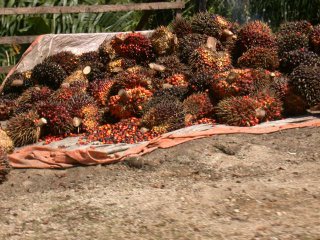
Fruit for sale. Roadside vendor.
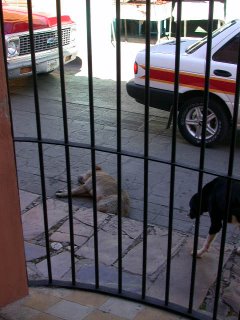

Dead street dog in San Cristobol. People don´t even seem to notice them. Just the passing dog and me.

Be prepared to pay to use public bathrooms. It´s also a good idea to carry your own toilet paper. This ticket entitled me to about 3 squares of tissue but a lot of places don´t provide any.
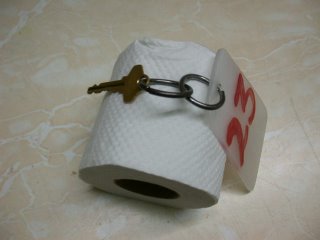
Our hotel in Halapa provided a full roll on payment with the room key. Nice place.

A sidewalk lunch stand
Driving through Mexico this way is like traveling the wheel of Samsara. The entire country, not just the Mayan ruins, is layer upon layer of post-apocalyptic world´s in ruin, chaotic, lovely, disturbing, simultaneously phantasmagorical and excruciatingly real. Being here is a combined spiritual bucket of cold water, slap in face and a wild, fresh wind, and overall a much needed and appreciated antidote to the suffocation and miasma of corporate Amerika.
We´re back in Chetumal after spending a few days camping on the Caribbean and visiting a few minor archaeological sites in the area. The Jeep part arrived two days early but the hotel held it for us. With all the pictures I took of palm trees, sea trash, the rising moon, buzzards and storm battered beach cabañas my photo count is now over 10,000. That means the ratio of photos to miles is more than 1:1.
I haven´t got any new ones transferred to the flash drive but here are a few random images from earlier in the trip. Today we´re driving to Calakamul, a new site that´s just beginning to be excavated. We´ll camp there tonight and spend the day there tomorrow. Then it´s back to the coast for a few days. After than, we´ll begin working our way up back up the gulf.

Zapatista road sign

Advertisement for our hotel in Palenque

Fruit for sale. Roadside vendor.


Dead street dog in San Cristobol. People don´t even seem to notice them. Just the passing dog and me.

Be prepared to pay to use public bathrooms. It´s also a good idea to carry your own toilet paper. This ticket entitled me to about 3 squares of tissue but a lot of places don´t provide any.

Our hotel in Halapa provided a full roll on payment with the room key. Nice place.
Labels:
Mexico,
photos,
road notes,
travel notes
05/11/2005
Biking to Bonampak
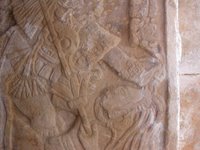
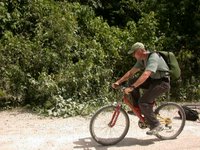
I´ve given up trying to keep up with this trip. So far we´ve put about 7000 miles on the Jeep and I´ve taken over 7000 photos (and deleted about a quarter of them). I know, obsessive-compulsive. Now we are far too far down the road to write or post in chronological order. We´re currently in Merida. To fill in a bit here´s a copy of an email Mr. Lee sent recently about our visit to the ruins at Yaxchilan and Bonampak. Naturally, I have photos to go with this but only have time to post a few at the moment.
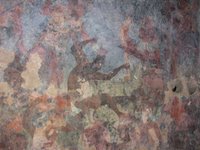

People used to say that the Mayans were completely peaceful but that just isn't so. Murals at Bonampak of ritual mutalation and killing. That's blood dripping from the captive's mutilated hands.
It would be hard for me to describe the past two days without sounding like some dime store adventure pulp, so I won't even try. I can't believe this sort of thing still exists in the 21st century. What follows is just a stream, unedited, typos and misspellings intact, just so I can get it down and then go to bed.
Departing Palenque, we took Hwy 307, a relatively new highway opening Mexico's last frontier, the Lancandon rain forest. It's a shame, really, but I guess humans won't stop until it's all gone. Well, it's not all gone yet.
We drove this road for about 100 miles, passing many tiny farming communities. Given that wood is in good supply and concrete in short supply, the pioneers all build with wood. It looks more like Belize than Mexico, with the exception that there is wave after wave of pioneers. Land that has become too poor to grow corn, beans and squash is burned to promote grass for cattle. Everyone looks fairly prosperous, in a rustic sort of way. As we continued down the new highway, we moved farther and farther back in time and the jungle increasingly pressed in on the road.We reached our destination within a couple hours. Formerly, the road to Frontera Corozal was an all day grind on rutted, pot-holed dirt. This new road will bring quick change, but for now, Frontera Corozal is a sleepy village (sounds cliche, but there's no better way to describe it--it feels more like the Caribbean in pace). These days, Frontera Corozal is the frontier for Mexican eco-tourism. It's a new concept here. The community runs the one lodge. Even though it's a monopoly, it's reasonable, clean and very efficient (although we well never, ever again order the "mojarra frita", a whole fried fish with an eerie piranha-like smile). We stayed in a thatch-roofed cabana with mosquito netting over the bed, nice fan, and tepid water for the shower. The lodge is also the place to book a boat ("lancha") for the hour-long ride down the Rio Usumacinta to Yaxchilan.
We chartered a boat that evening, to set off early in the morning before any potential tour buses. I met the pilot, and he agreed to meet us at 7am the next day. He was five minutes early, and eager to set off. Our boat was typical, a roughly 30 foot open canoe with giant outboard. With only the three of us, we flew over the water. Like the highway (in fact, the Rio Usumacinta has been a very efficient highway itself, for thousands of years), the farther we went, the lusher the forest. After a short time, we left the corn and bean fields behind and found ourselves in basically intact rain forest. We heard howler monkeys and parrots and saw all kinds of water birds.
By 8am, our pilot steered our boat into the mud bank at the foot of Yaxchilan. The mists were just lifting, and it was just getting light. For the next four hours, we were the only people at the site.
There were no guards, no tourists, no people at all. We explored at a leisurely pace, following an excellent guidebook. At one point, standing in the enormous main plaza next to a large stela covered by a giant plastic tarp, I heard what sounded like the start of a tropical downpour. I looked up, and the stream was hitting one spot on the tarp. There was a troupe of howler monkeys just above the tarp, in amongst some spawling tree branches, and they were just waking. Amazingly, the whole troop began to void their bowels at the same time, splatting all over the tarp. We were just far enough away to avoid the overflow.
They continued to stretch and crap for some time. We watched, riveted. They would be one of several different howler monkey troupes we would see that day. The monkeys were in the trees everywhere, the big males making that distinctive roar. What an incredible experience.
Yaxchilan is the rare Mexican preserve that combines actual preservation with lost city adventure and no settlements. Other than the Rio Usumucinta, there is no road to this site. That's the only thing that keeps it so well-protected.
Throughout the day, we visited ruins major and minor and saw the occasional colorful blur, including toucans and parrots. We agreed that this is one of the best things we've ever done.
The ride back was slower since we were going upstream,and our pilot recognized the value of treating people well, so he slowed or stopped for every turtle or crocodile. At one point, this master pilot drifted back quietly to a croc he'd passed (and we hadn't seen, despite our constant focus) and we moved to within 10 feet of the sleeping beastie--I think he was sleeping, because his mouth was wide open. Eventually, he roused and slid languorously into the water and wee moved on. Asha probably took about a thousand pictures.
(Well, not quite a thousand photos but I did get a couple of good close-ups, not with a telephoto lens though. I don't have one. The pilot actually got us this close to the crocodile. It was very cool but we stayed a bit too long and finally the guy slid off into the water to get away from us. We felt bad about it.)
The jeep was packed and ready to go on our return. We hit the road, heading for a campground near Bonampak. There are two Lancandon indian towns here, one more westernized (barely) and one more traditional. Although it was late in the day, I drove to the Bonampak entrance to scope it out for the next day. We were greeted by an old Lancondon man with traditional haircut (long hair, bangs) and western logger garb. On a whim, I asked him if we could camp there, and he checked with some other younger men, and it seemed fine. Time left in the day, we moved on to visit a local site and spread some pesos among the community, our bid to promote forest preservation and eco-tourism.
We took a hike to "las cascadas", one of the most perfect swimmin' holes I've ever seen, complete with sweltering air temps to promote water sporting. Along the way, we passed a tiny undocumented Mayan ruin.
We got back to the Bonampak entrance after closing, but I wasn´t concerned since there wasn't a gate. But all the folks I'd spoken with earlier were gone. In their place was an ancient albino Lancandon man. I don't speak Spanish that well, but it's passable--it was mesmerizing to talk with this man with his thick Maya accent. He spoke Spanish with the most remarkable inflection---I mean, holy shit, a Maya accent, how anachronistic is that? His eyes looked in different directions and his reddish white hair was cut in the traditional Lancondon style, long with bangs. I guess he must have hypnotized me or used some kind of albino shaman trick, because within minutes we were following his grandson to his house, his grandson having just harvested two giant squash from their "milpa" right next to the Bonampak entrance.We parked the jeep in a flat spot and tried to explain to people for whom Spanish is a distant second language that we were going to sleep in the "lancha" on top of our jeep, that we couldn't sleep in a hammock. I don't figure we could have appeared any crazier to these people, but on the other hand, they were looking pretty strange to us, too. The younger generation--there were four generations living here, the albino shaman grandfather the elder at 80--finally grasped that the white thingg on the jeep was a tent, but grandfather never wavered from his position that we were sleeping in our boat.
After some wild comparisons of our culture in Spanish, English and Mayan, the "artesanias" came out, and we were coerced, softly but relentlessly, into purchasing various necklaces and bracelets made out of local seeds. I knew it would happen. We were being ambushed. I bought some stuff, just enough I think.I spent an hour or so talking to grandsons, 20-somethings with some sense that there was a world beyond their own tiny village. Their world was so tiny. There are no schools beyond primary. Everyone works in the field to produce what they eat. There are no jobs. There's very little surplus. With the exception of western clothes and TVs and, amazingly, satellite cable with a hundred or more channels (which every shack had, no matter how humble, leading me to believe that maybe there's a gov't pacification campaign here, since this is still part of the Zapatista zone), these folks had nothing modern, and no possible way to get it or change their lives in any material sense. They all sold trinkets to tourists for folding money, which they wanted for sugar and soap. Again, this sounds like a cliche, but it's the reality as far as I could see.
The grandsons, I believe, had never seen a large map of Mexico, which I happened to have. They knew nothing of their country. They'd never ventured more than 100 miles from where they lived now, for generation after generation after generation. "No dinero", they kept saying, and sure, they were hitting us up hard, and as I say, we bought what we could, what felt comfortable. It got awkward when they invited us for dinner, since we were sure they'd charge in some fashion, and that dinner would be some kind of range chicken or gamey bush meat.
We pretended to be as tired as we really were, and popped the tent, bidding all a very early goodnight. It was just getting dark.
Culture shock would be putting things mildly here. This was more like a cultural nuke. We clammered into our tent, clothes still on, and doused the lights.
We had a very peaceful night. Upon wakening, we hoped that the folks would be working the fields early and we were right. We made a mad dash for the exit, leaving granny a two-pound box of Swiss chocolates and feeling like we'd all hit some kind of cultural snafu, both sides sort of quiet and sheepish.
Who knows what kind of story they're telling now?We reached Bonampak a few minutes later, dirty and a little crazed. We needed to eat. I popped open the back of the Jeep and poured a couple bowls of shredded wheat and raisins, and then I turned around and noticed the small crowd of Lancondones watching the morning's entertainment (us). It felt weird eating in front of these men, so I invited them to join us, distributing the last of our cereal into bowls and pans. One man asked if this is what we ate in America, and I said yes, sure. What is it made of? Wheat, said another, "trigo". I told them it was a different kind of cereal, not like the Mexican cereal since it lacked sugar. They treated it like an exotic dish and everyone ate everything and then washed bowls and spoons and fingers.
We rented decrepit bikes for the 6-mile ride to Bonampak. The site is very tiny, notable for its close alliance to Yaxchilan as a vassal city, and most famously, for its amazing murals. We saw reproductions in Mexico City and elsewhere, but there's no substitute for the actual setting (lost cities, monkeys, parrots, giant butterflies, albino Mayans).
We were filty and exhausted for our ride back to civilization, which, in this case, was Palenque, former hick town, now giant city with the perspective of a couple days in the Lacandon rain forest.
Now I'm going to surf aimlessly for a few minutes and then pester Asha to unplug so we can go to our room and crash. Next stop, Chetumal, sweet blessed funky Chetumal.
L.
Labels:
family,
guest blogger,
Mexico,
photos,
road notes,
travel notes
01/11/2005
Día de los Muertos
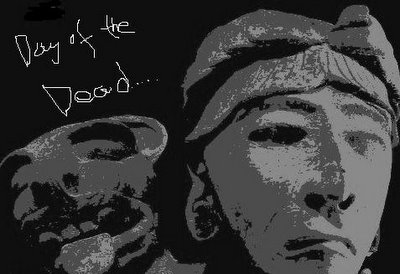
We are now in Compeche,
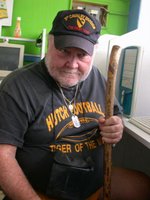 a small port city on the Gulf of Mexico. We didn´t stick around to meet with Dan the other day or try camping at the ruins. Instead we shot across the Yucatan in search of better weather, which we found here.
a small port city on the Gulf of Mexico. We didn´t stick around to meet with Dan the other day or try camping at the ruins. Instead we shot across the Yucatan in search of better weather, which we found here.
Today is Día de los Muertos, Day of the Dead, so in observation of it here are a few photos I´ve taken on the trip that are to me, in one way or another, in the spirit.
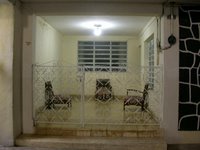
The first is of the waiting room for a funeral parlor. It is right on the sidewalk and cannot be closed off because it has no doors.
The rest have each their own mystery except for the photo from the miscellenia store (variety store) of the skulls on the artificial Christmas tree. That one is simply and delightfully absurd.

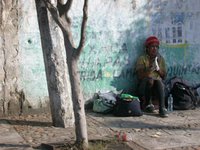

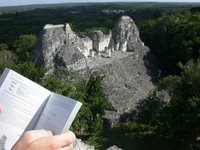
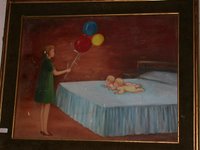
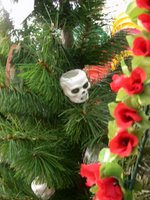
Happy Día de los Muertos and Merry Christmas!
Labels:
Mexico,
photos,
road notes,
travel notes
Subscribe to:
Comments (Atom)




